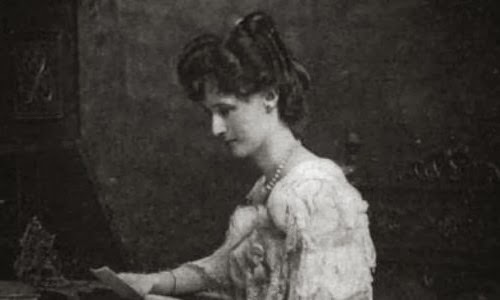 |
| Virginia Coventry, Viscountess Deerhurst [1] |
Victoria Melita’s Sapphires
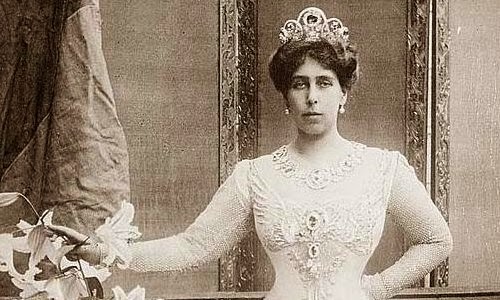 |
| Victoria Melita of Edinburgh as Grand Duchess Victoria Feodorovna, ca. 1909 [1] |
Another week, another look into Ducky’s jewel vaults! Today, we’re gazing upon one of the suites of jewelry that she inherited from her mother, Grand Duchess Maria Alexandrovna of Russia, Duchess of Edinburgh (and later Duchess of Saxe-Coburg and Gotha): her imperial sapphire parure.
The sapphire and diamond set was a present to Maria Alexandrovna on her wedding in 1874. Her groom was Prince Alfred, the second son of Prince Albert and Queen Victoria. The pair married at the Winter Palace in St. Petersburg, surrounded by her Romanov relatives. Along with a ruby tiara and a diamond fringe, Tsar Alexander II gave his daughter a parure of diamonds and sapphires. The set included the tiara, a necklace, and a stomacher that could be broken into two brooches.
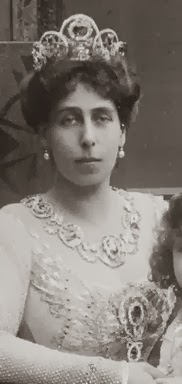 |
| Victoria Melita [2] |
The sapphires were designed with Maria’s future role in mind. The blue gems were set in diamond elements that included floral motifs symbolizing her new home: roses (for England), thistles (for Scotland), and shamrocks (for Ireland). In her write-up on the jewels, Ursula states that the sapphires had an even longer royal history than the set itself; they were inherited by the tsar from his mother, Alexandra Feodorovna (who was born Princess Charlotte of Prussia).
The parure was passed from Maria Alexandrovna to her second daughter, Victoria Melita. As we’ve discussed before, Ducky was unlucky in love; her first marriage to Ernst of Hesse was a bust, and her second wedding, to her cousin, Grand Duke Kirill Vladimirovich, was controversial. But she managed to hold on to the sapphires through both weddings. She was photographed in the complete parure in 1909, after she became Grand Duchess Victoria Feodorovna of Russia, but before she and the rest of the surviving Romanovs were forced to flee the country. In her biographical sketch of Ducky, Meriel Buchanan [3] describes the grand duchess wearing the sapphires during the Blessing of the Waters of the Neva ceremony in 1911: “the Grand Duchess Cyril looked magnificent, her train of cornflower-blue velvet lined with silver, a tiara of sapphires and diamonds blazing on her head, her blue eyes alight with happiness” [4].
Sadly, like so many jewels with Romanov connections, the whereabouts of this sapphire sparkler today are unknown. We know what happened to the necklace and the stomacher; Ducky sold them to Cartier in Paris after the Russian Revolution. (The sale probably happened around the same time she sold her Greek key kokoshnik to the Romanian royal family.) As for the tiara, who knows? I have a feeling it most likely met the same fate as Ducky’s other jewels. Times were tough for deposed royals, and nearly all of the surviving Romanovs sold off their gems to finance their post-imperial lives. I think it’s a safe bet that this piece was sold and likely broken up, joining so many other Russian tiaras in the mists of history [5].
2. Cropped version of an image in the public domain; source here.
3. Muriel was the daughter of Sir George Buchanan, the British ambassador to Russia.
4. You can read the full biography here.
5. A version of this post originally appeared at A Tiara a Day in November 2013.
Saturday Sparkler: The Ruby Olive Wreath Tiara
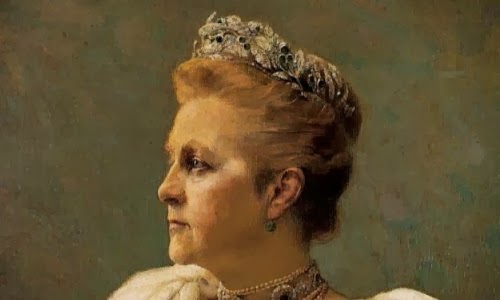 |
| Olga of the Hellenes wears the olive wreath tiara [1] |
Through all of their trials and tribulations (and assassinations and exiles, etc., etc.), the Greeks really have done a remarkable job of keeping their hands on (or, rather, getting their hands back on) their tiaras. Today’s sparkler, the Ruby Olive Wreath Tiara, is an example of an heirloom piece that has been reunited with the former royal family and remains with them today.
The olive wreath’s first royal wearer was Queen Olga, who was born a Russian grand duchess and became queen at the tender age of 16. The rubies in the tiara and the rest of the parure, which some think may have been sourced from her native Russia, are pigeon’s blood rubies, which sometimes look pinky-purple in certain lights. Apparently Olga’s husband, King George I of the Hellenes, purchased the rubies and had them set in the parure for his wife. When Olga died in 1926, she left the rubies to her son, Prince Nicholas. His wife, Elena Vladimirovna of Russia (AKA the woman who sold the Vladimir tiara to Queen Mary), wore the ruby set in a portrait. They also loaned the tiara to their daughter, Princess Marina, Duchess of Kent, who wore it to the State Opening of Parliament in October 1937.
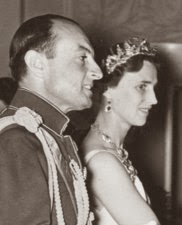 |
| Olga of Yugoslavia [2] |
Nicholas’s daughter, Princess Olga of Yugoslavia, was the next lucky person to own the tiara; she inherited the sparkler from her father in 1938. She wore the ruby parure in a portrait; she also, unfortunately, wore it during a visit to Berlin in 1939. Olga had several other tiaras, from both her own family and from the family of her husband, and this tiara apparently wasn’t one that she wore very often. The war years were not particularly kind to the Yugoslavian royals, who were exiled, and the tiara was sold.
But this was a good tiara sale, because the buyer of the tiara was none other than King Paul of Greece, Olga’s cousin. His wife, Queen Friederike, put the olive wreath tiara to good use during her husband’s reign, and after his death, she passed it along to the new queen, Anne-Marie. Anne-Marie brought the tiara with her when the monarchy was deposed for a final time, and she still wears the tiara and the rest of the ruby parure regularly today, along with many other pieces from the Greek royal collection [3].
2. Cropped version of a photograph available via Wikimedia Commons; source here.
3. A version of this post originally appeared at A Tiara a Day in April 2013.
- « Previous Page
- 1
- …
- 840
- 841
- 842
- 843
- 844
- …
- 857
- Next Page »